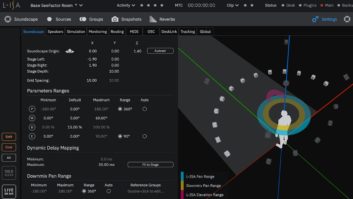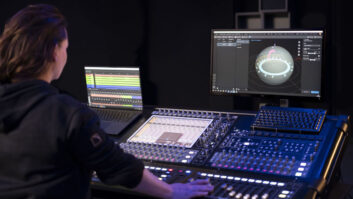
Indio, CA (July 22, 2022)—The annual Coachella festival in Indio, CA always has some eye-popping visuals to go with its two weekends of music. This year’s edition included an art installation by Cristopher Cichocki—the five-story-tall Circular Dimensions x Microscape, constructed with more than 25,000 feet of PVC tubes. The bandshell-shaped pavilion contained a living laboratory where scientists and artists generated experimental “video paintings” by manipulating water, salt, barnacles, and algae from the Salton Sea under microscopes and projecting that activity in real-time inside the pavilion’s “nucleus.”
Providing audio for those visuals was an L-Acoustics L-ISA immersive audio system based around 60 speakers, deployed by sound designers Jonathan Snipes, who teaches sound design in the theater department at UCLA, and Bobby McElver, a professor of wavefield synthesis at UC San Diego. The 57.1 system featured a combination of L-Acoustics X8 and 5XT coaxial loudspeakers supported by four SB18 subwoofers, while several Kiva II mini line arrays additionally delivered a mono version of the multichannel experience around the exterior of the tunnel.
The system was powered by the LA7.16i amplified controller; offering a 16×16 architecture in a 2U chassis with Milan-AVB redundancy, each of the unit’s 16 output channels delivers up to 1300 watts at 8 ohms or 1100 watts at 4 ohms.
“The audio I typically perform has a very three-dimensional spatialization aspect to it,” said Cichocki. “Bobby and Jonathan are sound-design professionals whom I’ve often worked with, and they suggested that L-ISA technology had the potential to take three-dimensional spatialization to the next level for Circular Dimensions. As it turned out, the bandshell type of environment I had designed for the installation was perfect for that.”
Living It Up Live With Dua Lipa
Cichocki developed hours’ worth of audio content for the installation and performance; these experimental sets evolved from ambient in the daytime to a high-energy dancefloor at night, all configured in eight channels and played through Ableton Live. However, it was only available in stereo format, raising the question: how does one create an engaging, immersive experience on the fly from only two channels?
To prepare for the event, Snipes and McElver spent a couple of days with Mosquera to create the system design for this project at the L-ISA Studio in Westlake Village, California, which also uses a large number of X8 and 5XT enclosures.
“Not knowing what tracks Cristopher would ultimately be using for his sets, Bobby and Jonathan took a variety of tracks—some percussive, some ambient, some melodic—and came up with numerous ways for the artist to control the movement of sound throughout the space with L-ISA,” Mosquera recalls. “First, they created a selection of snapshot presets that Cristopher could intentionally trigger from his iPad, which would cause the audio to move in specific ways around the loudspeakers inside the PVC tunnel. The intensity of these effects could also be controlled with a slider bar on his iPad, much like a wet/dry mix. Second, Bobby and Jonathan created multiple ‘reactive’ effects, which would also prompt audio trajectories—like sending everything to the center or panning audio in a wave from one side to the other. These would be automatically actuated when certain frequencies or other thresholds were crossed in the playback material. This second approach created some really interesting, creative movements without the artist having to initiate them personally. The two approaches combined allowed Cristopher to take any material he wanted to play and decorrelate just two channels into dozens of outputs in L-ISA, creating a pretty incredible aural experience.”
Through the larger final system onsite, as Cichocki was mixing on the fly, the audio content passed through processing engineered by Snipes and McElver. “Cristopher is a visual artist who provided the audio content, but wasn’t rearranging it. He’d be pulling from that content live in the moment, like a DJ, so we weren’t able to pre-author any trajectory information,” confirms McElver. “Instead, Jonathan and I built tools Cristopher could use to pull specific types of sounds and rhythms as he needed them. Some of those were reactive, and everything went through a real-time spectral and timbral analysis, so that it could be connected to other sounds and rhythms that way.”
McElver used Cycling 74’s Max 8 for that analysis, then set up macros using the snapshot feature in the L-ISA Controller, which allowed Cichocki to instantly call up specific bits of audio content, even as the rest of the content continued to play in automated mode through the L-ISA Processor II.
“Cristopher could see where the various audio objects were in the L-ISA Controller on the iPad, and he could change the speed and intensity of the other audio sources using an intensity slider we provided,” says McElver. “He could send sounds flying across the space—‘trajectory gestures’—but then the system would revert back to automated mode, so there was never any interruption to the sound.”







